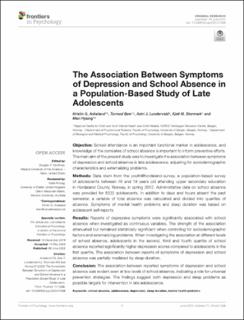| dc.contributor.author | Askeland, Kristin Gärtner | |
| dc.contributor.author | Bøe, Tormod | |
| dc.contributor.author | Lundervold, Astri J. | |
| dc.contributor.author | Stormark, Kjell Morten | |
| dc.contributor.author | Hysing, Mari | |
| dc.date.accessioned | 2021-02-09T14:28:10Z | |
| dc.date.available | 2021-02-09T14:28:10Z | |
| dc.date.created | 2021-01-22T18:05:01Z | |
| dc.date.issued | 2020 | |
| dc.identifier.issn | 1664-1078 | |
| dc.identifier.uri | https://hdl.handle.net/11250/2726973 | |
| dc.description.abstract | Objective: School attendance is an important functional marker in adolescence, and knowledge of the correlates of school absence is important to inform preventive efforts. The main aim of the present study was to investigate the association between symptoms of depression and school absence in late adolescence, adjusting for sociodemographic characteristics and externalizing problems. Methods: Data stem from the youth@hordaland-survey, a population-based survey of adolescents between 16 and 19 years old attending upper secondary education in Hordaland County, Norway, in spring 2012. Administrative data on school absence was provided for 8222 adolescents. In addition to days and hours absent the past semester, a variable of total absence was calculated and divided into quartiles of absence. Symptoms of mental health problems and sleep duration was based on adolescent self-reports. Results: Reports of depressive symptoms were significantly associated with school absence when investigated as continuous variables. The strength of the association attenuated but remained statistically significant when controlling for sociodemographic factors and externalizing problems. When investigating the association at different levels of school absence, adolescents in the second, third and fourth quartile of school absence reported significantly higher depression scores compared to adolescents in the first quartile. The association between reports of symptoms of depression and school absence was partially mediated by sleep duration. Conclusion: The association between reported symptoms of depression and school absence was evident even at low levels of school absence, indicating a role for universal prevention strategies. The findings suggest both depression and sleep problems as possible targets for intervention in late adolescence. | |
| dc.language.iso | eng | |
| dc.rights | Attribution 4.0 International (CC BY 4.0) | |
| dc.rights.uri | https://creativecommons.org/licenses/by/4.0/ | |
| dc.title | The association between symptoms of depression and school absence in a population-based study of late adolescents | |
| dc.type | Peer reviewed | |
| dc.type | Journal article | |
| dc.rights.holder | © 2020 Askeland, Bøe, Lundervold, Stormark and Hysing | |
| dc.description.version | publishedVersion | |
| cristin.ispublished | true | |
| cristin.fulltext | original | |
| cristin.qualitycode | 2 | |
| dc.identifier.doi | 10.3389/fpsyg.2020.01268 | |
| dc.identifier.cristin | 1877473 | |
| dc.source.journal | Frontiers in Psychology | |
| dc.source.volume | 9 | |
| dc.source.issue | 11 | |

